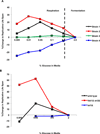Yeast as a model to understand the interaction between genotype and the response to calorie restriction
- PMID: 22828279
- PMCID: PMC4016815
- DOI: 10.1016/j.febslet.2012.07.038
Yeast as a model to understand the interaction between genotype and the response to calorie restriction
Abstract
Calorie restriction is reported to enhance survival and delay the onset of age-related decline in many different species. Several proteins have been proposed to play a role in mediating the response to calorie restriction, including the target of rapamycin kinase, sirtuins, and AMP kinase. An enhanced mechanistic understanding of calorie restriction has popularized the concept of "calorie restriction mimetics", drugs that mimic the beneficial effects of caloire restriction without requiring a reduction in nutrient intake. In theory, such drugs should delay the onset and progression of multiple age-related diseases, similar to calorie restriction in mammals. Despite the potential benefits of such calorie restriction mimetics, however, relatively little is known about the interaction between genetic variation and individual response to calorie restriction. Limited evidence from model systems indicates that genotype plays a large role in determining both the magnitude and direction of effect that calorie restriction has on longevity. Here we present an overview of these data from the perspective of using yeast as a model to study aging and describe an approach we are taking to further characterize the molecular mechanisms underlying genotype-dependent responses to calorie restriction.
Copyright © 2012 Federation of European Biochemical Societies. Published by Elsevier B.V. All rights reserved.
Figures


References
-
- McCay CM, Crowell MF, Maynard LA. The effect of retarded growth upon the length of life and upon ultimate size. The Journal of nutrition. 1935;10:63–79.
-
- Masoro EJ. Overview of caloric restriction and ageing. Mech Ageing Dev. 2005;126:913–922. - PubMed
-
- Weindruch R, Walford RL, Fligiel S, Guthrie D. The retardation of aging in mice by dietary restriction: longevity, cancer, immunity and lifetime energy intake. The Journal of nutrition. 1986;116:641–654. - PubMed
Publication types
MeSH terms
Grants and funding
LinkOut - more resources
Full Text Sources
Molecular Biology Databases

